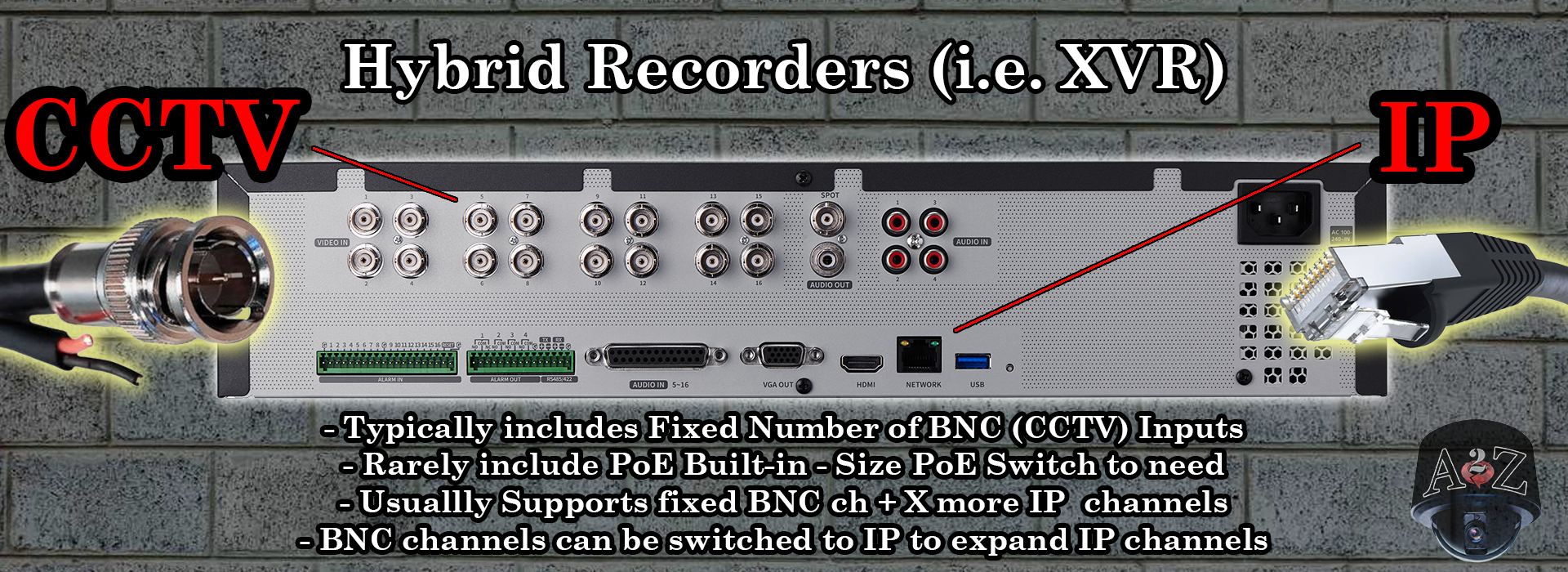Analog & HD CCTV vs. IP Cameras – CCTV & IP Security Camera Systems

By Justin C., Video Security System Specialist — A2Z Security Cameras
Introduction
The choice between HD-over-Coax (Analog HD) and IP (network) cameras is one of the most important decisions when designing or upgrading a surveillance system. While IP technology has surged in popularity, modern coax-based systems — including standards like HD-TVI, HD-CVI, and AHD — have evolved far beyond the grainy images of older CCTV setups.
Today, true “analog CCTV” (CVBS) is largely obsolete outside of old stock or very specific low-resolution applications. However, most modern HD-over-Coax devices still support CVBS signals for backwards compatibility with older cameras and recorders — a factor that can be significant for certain upgrade projects, as we’ll explore below.
Each approach has strengths, limitations, and ideal use cases. The right decision depends on your site infrastructure, image quality needs, budget, and long-term scalability goals.
What is HD-over-Coax (Analog HD)?
HD-over-Coax cameras capture high-definition video and transmit it as an analog signal over coaxial cable (often RG59 or RG6). They support resolutions from 1080p up to 4K without requiring a full network-based system. Many also transmit audio, data, and/or control signals over the same cabling with the proper equipment.
Key Features: - Simple point-to-point connection from camera to DVR/XVR - No network dependency, potential for lower latency video - Lower cost per camera in many cases - Mature, reliable cabling technology with backward compatibility for CVBS
Common Use Cases: - Sites with existing coax infrastructure - Budget-conscious upgrades to higher resolution - Locations with minimal IT support needs
What is an IP Camera?
IP cameras capture and process digital video, transmitting it over Ethernet (Cat5e/Cat6) networks. They can often record locally on the camera itself via “edge storage,” send video directly to a Network Video Recorder (NVR), or transmit to cloud services. Most modern IP cameras support PoE (Power over Ethernet) for simplified cabling.
Key Features: - Higher maximum resolutions (up to 32MP and beyond) - Advanced features like onboard analytics, multi-streaming, and remote configuration - Flexible integration with other IP-based systems, including non-security applications - Wide variety of designs and specifications for specialized needs
Common Use Cases: - New builds with structured cabling - Complex deployments with analytics and integration needs - Large campuses or multi-site networks
Side-by-Side Comparison
| Feature | HD-over-Coax (Analog HD) | IP Cameras (Network) |
|---|---|---|
| Max Resolution | 1080p to 4K (depending on DVR/camera) | 1080p to 32MP+ |
| Cabling | Coaxial cable + PWR (or UTP with baluns) | Single Ethernet cable with PoE or separate PWR |
| Image Latency | Very low | Low to moderate depending on network quality |
| Analytics | Limited (DVR/XVR-based) | Extensive (camera and/or NVR-based) |
| Upgrade Path | Limited to DVR/XVR/camera capabilities | Highly scalable — add cameras, storage, analytics |
| Cost per Camera | Often lower | Generally higher upfront, but more feature-rich |
| Network Impact | Minimal | Significant — requires proper network design |
| Install Complexity | Simple (plug-and-play) | Requires network setup knowledge |
Key Factors to Consider
1. Image Quality & Resolution
- HD-over-Coax has caught up significantly — 4K over coax is now possible — but IP still leads in maximum resolution and sensor variety.
- IP offers more specialty options (fisheye, panoramic, multi-sensor, motorized zoom) that can cover wider areas with fewer cameras and cabling runs.
2. Cabling & Infrastructure
In addition to fixed building installations, specialized environments can influence the choice between HD-over-Coax and IP. For example, tactical, mobile, and solar-powered surveillance units often adopt IP systems because of their flexibility, compact multi-sensor options, and advanced analytics capabilities in remote or wireless deployments. However, HD-over-Coax remains a strong performer in certain applications, such as mobile surveillance on buses, trucks, taxis, trains, or heavy vehicles, where coaxial cabling’s durability and resistance to network interference can be advantageous, and where systems often use unique cabling and equipment characteristics. Environmental factors like extreme temperatures, vibration, or long-distance cable runs can also dictate which technology will be most reliable.
3. Features & Analytics
With IP-based surveillance, cybersecurity is a critical part of system design. Cameras and NVRs become part of your network, which means they need strong passwords, VLAN segmentation, firmware updates, and monitoring to reduce vulnerability to unauthorized access. While HD-over-Coax systems aren’t immune to tampering, their video feeds are not directly exposed to the internet or network unless paired with network-enabled recorders, making them less susceptible to remote cyberattacks — or at least exposed at fewer hardware points. From Video Analytics to AI Video Analysis, systems today now include a broad range of potential enhanced detection methods and added fuctions that can vary greatly from product to product.
4. Scalability
- Both technologies are constrained by recorder channel limits — expanding often means adding another recorder.
- IP systems can extend coverage more flexibly by distributing PoE switches across a property rather than home-running all cables to a central location.
- VMS platforms with open licensing can manage many IP recorders as one system, allowing larger scaling potential.
5. Cost & Budget
When comparing solutions, it’s important to consider total cost of ownership over time — not just the upfront hardware cost. For example, a 16-camera retrofit using existing coax may cost 30–40% less initially than replacing with IP, but may require an earlier full-system upgrade if advanced analytics, specialized functions, or even higher resolutions not currently available in coax-based solutions become essential later. Conversely, an IP-based campus installation may have higher startup costs but could integrate new camera types and features over the next decade without major cabling changes, ultimately reducing replacement cycles and installation labor.
As such, each project’s variables can differ — and this is why both system types are still widely adopted.
Modern Hybrid Systems
Hybrid DVR/NVRs (XVRs) can accept both coax and IP camera inputs, allowing gradual upgrades: - Keep existing coax-based cameras in service - Upgrade to HD-over-Coax without replacing cabling - Add IP cameras where higher resolution or advanced features are needed - Spread upgrade costs over time
Real-World Deployment Examples
Small Retail Store
- Often benefits from IP cameras for entrances, POS areas, and high-value zones due to better detail, integrated audio options, and remote management.
- If a store already has functional coax wiring, upgrading to HD-over-Coax for general coverage can be cost-effective.
- Many small retailers mix both: IP for detail-critical views, HD-over-Coax for budget-friendly perimeter or backroom coverage.
School Campus
- IP is often the preferred choice for new buildings and large outdoor spaces, offering centralized management, high-resolution coverage, and advanced analytics.
- Where significant coax infrastructure exists in older wings, HD-over-Coax can still serve well for hallways or low-traffic areas, reducing retrofit costs.
- A phased migration plan allows schools to adopt IP gradually while maintaining operational coverage.
Government Building
- New or high-security installations typically favor IP for resolution, encryption, and integration with access control or analytics platforms.
- Existing coax-based systems can still play a role in less critical areas, especially when budgets prioritize securing key entry points and perimeter zones first.
- Modern hybrid recorders and software platforms allow both technologies to be managed in one interface during transitions.
Takeaway: In today’s market, IP is in higher demand due to its flexibility, higher resolution, and integration potential. However, HD-over-Coax remains a strong option when reusing infrastructure, controlling costs, or keeping installations simple — and hybrid systems can bridge the gap.
Expert Insights
- Don’t underestimate modern analog — HD-over-Coax can now deliver 1080p to 4K video, making it a viable upgrade path when reusing existing coaxial infrastructure. This can save thousands in cabling costs during renovations.
- Plan for growth — Even if starting with HD-over-Coax, choose hybrid recorders and software platforms that can accept IP channels later. This allows phased migration without replacing the entire recording system.
- Bandwidth & network health matter — IP cameras demand stable, well-planned networks. Use dedicated VLANs, quality switches, and sufficient uplink capacity to avoid latency and dropped frames.
- Power strategy is critical — PoE simplifies IP installation, but confirm your switches, PoE budgets, and UPS systems can handle peak loads, especially during power outages.
- Feature gaps still exist — IP cameras often offer superior analytics, encryption, and integration options compared to coax systems. Decide early if these capabilities are essential to your goals.
- Maintenance considerations — HD-over-Coax systems can be easier for small teams to troubleshoot since they don’t require deep IT/networking expertise. IP systems may need coordination between security and IT staff.
Future Trends in Surveillance Technology
The surveillance market continues to evolve rapidly. AI-driven analytics at the edge (in the camera itself) are becoming standard, enabling advanced functions like object classification, behavior detection, and automated alerts without relying entirely on the recorder. Cloud-based video management systems (VMS) are gaining traction, allowing secure remote access, scalable storage, and easier multi-site management — especially for IP systems and in varied deployment scenarios.
While HD-over-Coax technology is expected to remain relevant for at least the next 5–10 years, especially in cost-sensitive and retrofit scenarios, most manufacturers are directing their primary innovation toward IP. That said, multiple major manufacturers continue to produce new HD CCTV lines, meaning the long-term market balance is still uncertain. Multi-sensor units, panoramic cameras, ultra-high-resolution models, and more advanced camera-level functions are becoming more common in IP lines, offering capabilities coax-based systems cannot easily match in their current form. Planning infrastructure with these trends in mind will help ensure an investment stays competitive as the industry evolves — and aligned with your site’s specific needs.
Conclusion
The decision between HD-over-Coax and IP cameras comes down to matching the technology to your operational needs, budget, and existing infrastructure.
IP cameras dominate many new installations not only for their higher resolution, advanced analytics, and integration potential, but also because of the wider range of models, features, and specialized designs available. For sites with extensive existing coaxial cabling or limited budgets, modern HD-over-Coax systems can still deliver excellent image quality with minimal disruption.
In some projects, blending both technologies may be beneficial, while in others, committing to one approach from the start makes more sense. The key is to evaluate your specific site conditions, long-term goals, and performance requirements so the system you choose delivers lasting value and effectiveness.
Next Steps
- Read: Choosing the Right Resolution – 1080p, 4MP, 4K, and Beyond
- Read: Wired vs. Wireless Surveillance Systems Guide
- Browse our Video Recorders DVR, XVR, NVR, VMS Products Categories
- Checkout Our Security Camera Video Storage Calculator Tool
- Contact our design team to discuss your upgrade path.
